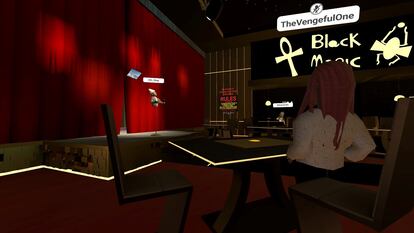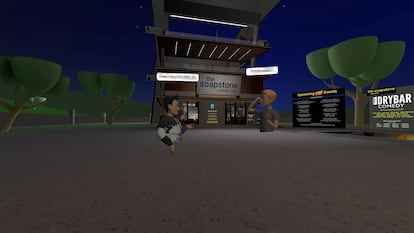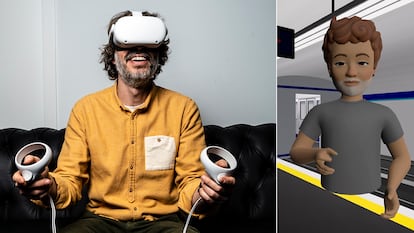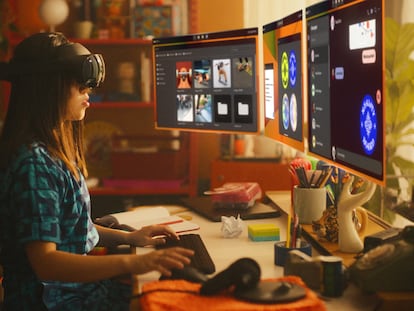A day in the metaverse: Empty settings, flirting avatars and children talking to strangers
Meta has two other equally serious problems. First, the headset battery lasts between one and two hours, depending on the use. Also, people get tired of it and don’t use it a lot after trying the experience
I am in a pool, in the metaverse, and I can’t get out. There is no ladder. I also can’t swim. I look down and I see the bottom; I float but I don’t have any legs and I can’t touch the floor. It’s an uncomfortable feeling, but not a distressing one, because none of this is really happening. Although it is.
The owner of this metaverse gym taught us how to grab some boards and move them around to swim. He then jumped into the pool and swam very fast. When I jumped, the boards slipped out of my hands. I couldn’t move. I asked for help, but the others ignored me. To save myself – to save my avatar – I had to exit the metaverse. This scene that goes from curiosity to bewilderment and loneliness sums up my long journey through Meta’s virtual reality platform.
The metaverse is a concept that has come to mean many things, and with billions of dollars invested in technologies and resources over the last decade, Meta (formerly known as Facebook) is the company that has bet the most on this new terrain. For this experience I focused on Horizon Worlds, Meta’s flagship social platform for its metaverse. The Worlds are hundreds of settings where you can chat, play, watch shows or just hang around and pretend to drink something. I visited squares, Western towns, islands where you get shot at, theaters, empty city streets, apartments and many other futuristic sets where, in reality, not much happens. Here, meeting people is just one option: there are also traditional videogames, exercise games and virtual meeting rooms where you can work with other avatars.






Where to start
All you need is a VR headset and a Meta account. For this experiment I used a Meta Quest 2, whose price starts at $399.99. Before entering you need to create an avatar: you choose the eyes, hair, glasses, clothes and everything you want to be wearing in the metaverse (except pants, because currently the avatars have no legs). Then you learn how to pick up objects and move around with the controllers. My first realization was that sliding through the metaverse makes me dizzy; to move, I have to teleport.
Once you have an avatar, you can choose from a list of worlds to enter: the selection of the day, worlds to play, worlds to watch. On those lists you can see how many people are currently in each world; I never saw any with more than 100 visitors, and most had just a handful. Right now, Horizon Worlds is only available in seven countries.
The metaverse was one of the main innovations of 2020. With the confinement, a virtual world in which to work, meet or have fun seemed essential. Since then, however, its significance has decreased. According to documents reviewed by The Wall Street Journal, in October 2022 there were less than 200,000 monthly Horizon Worlds active users; the company’s goal had been 500,000 by year’s end, but it later changed it to 280,000.
Meta has two other equally serious problems. First, the battery lasts between one and two hours, depending on the use. Also, people get tired of the headset and don’t use it a lot after trying the experience. Even Meta’s own employees seem unenthusiastic. Prolonged use causes tiredness and some dizziness. My visits to the metaverse were limited to isolated moments because my head felt heavy. Some people sit down and plug the charging cable so they can spend more hours, but I just couldn’t.

The voices of children
When you enter a world with a few dozen people in it, you see avatars moving around fast like minions. In some places, moderators greet you upon arrival. And while the faces are fake, the voices are real. That makes it easy to identify, for example, small children. I asked one his age and he said: “My mother told me not to answer that question or give any personal information.” The recommended age is 13 and up, but there are plenty of younger kids roaming the metaverse. And they behave like children. One boy was trying to take the wings off a woman; “Have some manners!” she said. He replied, “Manners are boring!”
The avatar is impersonal, but the voice gives interactions a different dimension. It is not the same detachment with which one writes a text message; it is more like talking on the phone. It was not me, my face had no expression, I could turn and go away or disappear and nothing would have happened. But it was my real voice speaking, and in the answers I got I could sense contempt, comfort or tension.
Most of the interactions I’ve seen or had have been banal or outright trolling. One of the theaters has a bar with donuts, and an avatar kept eating dozens, one after another, while another who pretended to be a waitress looked on with a look of supposed surprise. In a world called “Very British Pub,” two avatars discussed whether the right term was “crisps” or “chips.”
A virtual society
Elle and Stephen were flirting outside the Soapstone Comedy Club. “What do you like? What are you passionate about? Apart from me, of course,” said Stephen. Elle replied: “I work in movies and photography, but I like many things.” They seemed to be holding virtual hands. Then, some guy joined Elle and Stephen and broke the mood. Avatars have safety modes that help you put some distance between you and other people, mute them, or mute yourself. Another day I saw Stephen in a different bar chasing a different female avatar: “Here’s your daddy, baby.”
Another conversation I witnessed – a more endearing one – was held between a boy and an older man who was sitting on a bench. The boy asked if he remembered him; they had met a year and a half before, and now he was at home, unable to go to school due to illness. “I came out to see people,” he added. The gentleman, with an affectionate tone, replied that he did not remember him. Then the boy asked, “I want to go to this concert. Will you come with me?” A virtual theater with a huge screen was showing a Notorious B.I.G. concert. In difficult real-life situations, such as health problems, the feeling of companionship that the metaverse can provide can be a great help.
Some worlds were created by Meta, but most are created by individual designers. And like any other place you can visit, the metaverse has tours. I made it to the pool where I drowned because the creator of the gym invited some of us on a tour. He showed us punching bags, the yoga room, the juice bar, the squash room and an area with volleyball, wall climbing and a basketball basket. Then, before jumping into the pool, he asked us for a like to promote his gym.
It is still impossible to know if there will be enough people interested in virtual reality in the next few years to turn it into a business. Videogames seem like an obvious use for a VR headset, but there are less people playing videogames than on social media, which is the goal of Horizon Worlds: to be a place to meet. On a stroll through the back streets of a city, I entered an empty theater and saw skyscrapers and cars in the distance. There were empty stores that rented out their windows for $79 a month. Will there be enough pedestrian traffic to make renting a store like that a viable business? It seems unlikely today, but you never know.
Sign up for our weekly newsletter to get more English-language news coverage from EL PAÍS USA Edition
Tu suscripción se está usando en otro dispositivo
¿Quieres añadir otro usuario a tu suscripción?
Si continúas leyendo en este dispositivo, no se podrá leer en el otro.
FlechaTu suscripción se está usando en otro dispositivo y solo puedes acceder a EL PAÍS desde un dispositivo a la vez.
Si quieres compartir tu cuenta, cambia tu suscripción a la modalidad Premium, así podrás añadir otro usuario. Cada uno accederá con su propia cuenta de email, lo que os permitirá personalizar vuestra experiencia en EL PAÍS.
¿Tienes una suscripción de empresa? Accede aquí para contratar más cuentas.
En el caso de no saber quién está usando tu cuenta, te recomendamos cambiar tu contraseña aquí.
Si decides continuar compartiendo tu cuenta, este mensaje se mostrará en tu dispositivo y en el de la otra persona que está usando tu cuenta de forma indefinida, afectando a tu experiencia de lectura. Puedes consultar aquí los términos y condiciones de la suscripción digital.
More information
Archived In
Últimas noticias
ChatGPT fails the test: This is how it endangers the lives of minors
The late consecration of women artists in their 90s
The Florida Keys tourist paradise is besieged by immigration agents: ‘We’ve never seen anything like this’
The latest scam on WhatsApp behind the legal dream: using immigration status as bait
Most viewed
- Families demand repatriation of bodies of Colombians who died in Ukraine: ‘This war is a slaughterhouse for foreigners’
- The low-cost creative revolution: How technology is making art accessible to everyone
- Liset Menéndez de la Prida, neuroscientist: ‘It’s not normal to constantly seek pleasure; it’s important to be bored, to be calm’
- Christian Louboutin: ‘Young people don’t want to be like their parents. And if their parents wear sneakers, they’re going to look for something else’
- ‘El Limones’ and the growing union disguise of Mexican organized crime












































